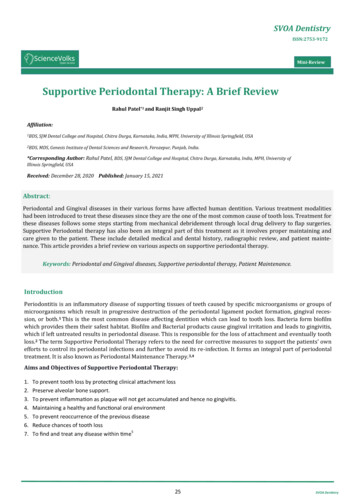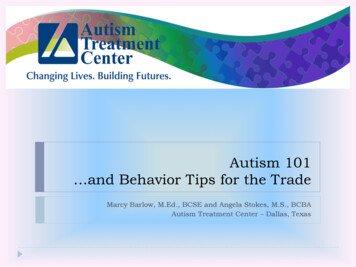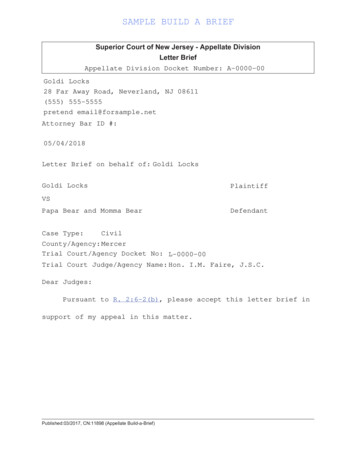
Transcription
SVOA DentistryISSN:2753-9172Mini-ReviewSupportive Periodontal Therapy: A Brief ReviewRahul Patel*1 and Ranjit Singh Uppal2Affiliation:1BDS, SJMDental College and Hospital, Chitra Durga, Karnataka, India, MPH, University of Illinois Springfield, USA2BDS, MDS, GenesisInstitute of Dental Sciences and Research, Ferozepur, Punjab, India.*Corresponding Author: Rahul Patel, BDS, SJM Dental College and Hospital, Chitra Durga, Karnataka, India, MPH, University ofIllinois Springfield, USAReceived: December 28, 2020 Published: January 15, 2021Abstract:Periodontal and Gingival diseases in their various forms have affected human dentition. Various treatment modalitieshad been introduced to treat these diseases since they are the one of the most common cause of tooth loss. Treatment forthese diseases follows some steps starting from mechanical debridement through local drug delivery to flap surgeries.Supportive Periodontal therapy has also been an integral part of this treatment as it involves proper maintaining andcare given to the patient. These include detailed medical and dental history, radiographic review, and patient maintenance. This article provides a brief review on various aspects on supportive periodontal therapy.Keywords: Periodontal and Gingival diseases, Supportive periodontal therapy, Patient Maintenance.IntroductionPeriodontitis is an inflammatory disease of supporting tissues of teeth caused by specific microorganisms or groups ofmicroorganisms which result in progressive destruction of the periodontal ligament pocket formation, gingival recession, or both.1 This is the most common disease affecting dentition which can lead to tooth loss. Bacteria form biofilmwhich provides them their safest habitat. Biofilm and Bacterial products cause gingival irritation and leads to gingivitis,which if left untreated results in periodontal disease. This is responsible for the loss of attachment and eventually toothloss.2 The term Supportive Periodontal Therapy refers to the need for corrective measures to support the patients' ownefforts to control its periodontal infections and further to avoid its re-infection. It forms an integral part of periodontaltreatment. It is also known as Periodontal Maintenance Therapy. 3,4Aims and Objectives of Supportive Periodontal Therapy:1.2.3.4.5.6.7.To prevent tooth loss by protecting clinical attachment lossPreserve alveolar bone support.To prevent inflammation as plaque will not get accumulated and hence no gingivitis.Maintaining a healthy and functional oral environmentTo prevent reoccurrence of the previous diseaseReduce chances of tooth lossTo find and treat any disease within time525SVOA Dentistry
Supportive Periodontal Therapy: A Brief ReviewTypesIn 1981 Snider and Schallhorn classified Supportive Periodontal Therapy into 4 types 6TYPE-IPreventive MaintenancePatient with healthy periodontal structuresTYPE-IITrial Maintenance TherapyPatient with mild to moderate periodontitisTYPE-IIICompromised Maintenance TherapyPatients where active therapy is not possibleas in cases with medically compromisedTYPE-IVPost-treatment Maintenance TherapyMaintenance to prevent reoccurrence of thediseaseBefore going in to details of the Supportive Periodontal Therapy, various phases of periodontal treatment have beendescribed in the following section.Phases of Periodontal Treatment7:Phase –INon-Surgical PhasePhase-IISurgical PhasePhase-IIIRestorative PhasePhase-IVMaintenance Phase –I (Non-Surgical): It includes plaque control1. Scaling and root planing2. Evaluation of carious tooth followed by its restoration.3. Removal of any prosthetic and restoration that causes irritation4. Split therapy to correct MPDS5. Splinting of teeth6. Minor orthodontic adjustment7. Provisional Restoration8. Extraction of any grossly decayed tooth9. Diet control26SVOA Dentistry
Supportive Periodontal Therapy: A Brief ReviewPhase-II (Surgical Phase): It includes1. Periodontal Flap surgeries2. Implant placement3. Endodontic surgeriesPhase-III (Restorative Phase): It includes1. Removable or fixed prosthetic appliances2. Final restorations3. Periodontal examinationsPhase-IV (Maintenance Phase): It includes periodic recalls visits to have long term success of the treatment. The interval between treatments is initially 3 months which can be varied according to the requirement of the patients. 8Supportive Periodontal Therapy: Flow ChartMaintenance ation andDiagnosisMotivation, reinstruction andinstrumentationTreatment of Re-infected sitesPolishing of entire dentition, fluoride applicationSupportive Periodontal Therapy can be divided in to four parts. These are as follows:Part-IIt involves multi-risk assessment i.e. site risk assessment, tooth risk assessment, periodontal risk assessment.1.2.3.4.General examinationDetailed dental or medical historyIntra-oral examinationHard tissue examination9- 5.Soft tissue examination 6.7.Examination for cariesExamination for any tooth fractureTooth mobilityImplant evaluationRestoration evaluationOcclusal changespocket depthGingival changesExamination of any prosthesis, if presentCheck for any other sign or symptoms by the patient27SVOA Dentistry
Supportive Periodontal Therapy: A Brief ReviewPart-II1. Motivates patient to maintain oral hygiene2. Only though sites should be re-instrumented this shows signs of inflammation or active disease progression. 93. Informing the patient about the benefits to maintain hygiene.Part-III1.2.3.4.It starts with mechanical debridement i.e. scaling and root planing.Generalized re-infection is usually the result of inadequate Supportive periodontal therapy. 9Localized re-infection can be either due to inadequate plaque control or the formation of the bacterial nidus.Usually, furcation sites or sites with difficult access are re-infected.Part-IV1.2.3.4.5.Polishing of entire dentition to remove any remaining soft deposits, followed by fluoride application. 10Fluoride application to decrease chances of cariesRefer for prosthetic, orthodontic, or restorative treatmentSchedule for recall intervalOral hygiene updateOn the basis of severity of gingival or periodontal disease, oral hygiene maintenance by the patient and compliance. Merin in 1996 proposed classification for recall interval for different types of patients as shown in the following table. 11ClassificationRecall intervalFirst-year3 monthsFirst-year1-2 monthsClass A6 months to 1 yearClass B3-4 monthsClass C1-3 monthsCharacteristicsRoutine scaling and root planing and uninterruptedhealingIt is usually indicated in cases with: Poor crown root ratio Furcation involvement Tooth with questionable prognosisIt is in patients with excellent result, well maintainedfor 1 year or more No gingival pockets No occlusal problem Minimal calculus Good oral hygieneGood result maintained for 1 year or more Presence of gingival pockets Occlusal problems Presence of moderate calculus Bleeding on probing Some teeth with less than 50 % bone support Poor oral hygiene Recurrent dental caries SmokingPoor results Presence of gingival pockets Occlusal problems Presence of heavy calculus Bleeding on probing Poor oral hygiene Recurrent dental caries More teeth with less than 50 % bone support Periodontal surgeries required Severe occlusal problems28SVOA Dentistry
Supportive Periodontal Therapy: A Brief ReviewRole of the patient in Supportive Periodontal therapyAlthough motivation plays a key role to carry supportive periodontal therapy other factors should also be consideredsuch as the method should be simple to carry, easy to understand, accommodates the patient's needs. It includes:1. Toothbrush: either electric or manual along with interproximal cleaning with interdental brushing, dental floss, andtongue cleaner.2. Fluoride gels: either on toothpaste or in custom fabricated trays.3. Oral irrigators: includes anti-microbial solutions or mouthwashes.12Supportive Periodontal Therapy in Orthodontic Patient13Oral HygieneTrauma from OcclusionPeriodontal diseasesBefore treatmentThe instruction is given tothe patient regarding themaintenance of oral hygieneEliminated, if any presentDuring treatmentConstant motivation to thepatient to follow proper oralhygiene, band to be placedaway from gingival sulcus tohave an effective cleaningFremitus removedIf any sign of inflammation,start with scaling or rootplanning or any flap treatment, if requiredThe patient is seen for oralprophylaxisAfter treatmentTooth mobility monitored6 months after tooth mobilityThe patient kept on maintenance and re-evaluated 6months after tooth movementsSupportive Periodontal Therapy in Patient with Gingivitis or Periodontitis14Instruction to the patient to maintain oral hygieneRemoval of supra or sub-gingival calculusUse of mouthwashes to add on the benefits of mechanical debridementRemoval of any plaque retentive factors such as overhanging crowns, ill-fitting dentures, narrow embrasuresOnce active therapy is completed, periodic follow upSupportive Periodontal Therapy for Patient with Implants15It is also known as Cumulative Interceptive Supportive Therapy (CIST). It involves three basic guidelines that need tofollow:1. Radiographic examination2. Clinical examination3. Supportive therapy for infection controlAll these factors help to evaluate and intercept the progression of Peri-Implant diseases. The therapy includes 4steps:Step 1: Antiseptic Therapy with protocol AStep 2: Antibiotic therapy with protocol A BStep 3: Antibiotic therapy with protocol A B CStep 4: Antibiotic therapy with protocol A B C D29SVOA Dentistry
Supportive Periodontal Therapy: A Brief ReviewProtocolPeriodontalProbing depth 3mmBleeding onprobingNegativeBone lossTreatmentNegativeMechanical debridement 3mmPositiveNegativeMechanical debridement PolishingB4-5mmPositiveNegativeC 5mmPositiveD 5mmPositiveNotable cratering ( 2mm)Bone loss 2mmAntibiotic Cleaning 0.1 % Chlorohexidine Gel twice a day for 3-4 weeksSystemic AntibioticsARegenerative SurgeryIn 2007, a study was conducted by Kasaj et.al states that chlorohexidine chip can be an adjunctive therapy to scalingand root planing. And sever as a beneficial effect on moderate to severe chronic periodontitis. 16ConclusionPeriodontal maintenance therapy both patient and dentist work hand-in-hand, making it easier to control the circumstances that leads to inflammatory diseases. But still, sometimes complications can be seen such as dental caries, rootsensitivity, endodontic lesions, and periodontal abscess. 17 The key to success is a constant reminder to the patient regarding the importance and advantage of long term maintenance in preventing periodontal and peri-implant diseaseprogression.References1.Newman, M.G., Takei, H., Klokkevold, P.R. and Carranza, F.A., 2011. Carranza's clinical periodontology. Elsevierhealth sciences.2.Dentino, A., Lee, S., Mailhot, J. and Hefti, A.F., 2013. Principles of periodontology. Periodontology 2000, 61(1), pp.1653.3.Cohen RE; Research, Science and Therapy Committee, American Academy of Periodontology. Position paper .Periodontal Maintenance. J Periodontol. 2003 Sep;74(9):1395-401.4.Ramfjord SP, Morrison EC, Burgett FG, Nissle RR, Shick RA, Zann GJ, Knowles JW. Oral hygiene and maintenance ofperiodontal support. Journal of Periodontology. 1982 Jan 1;53(1):26-30.5.Lindhe, J. and Nyman, S., 1984. Long‐term maintenance of patients treated for advanced periodontal disease. Journal of clinical periodontology, 11(8), pp.504-514.6.Schallhorn, R.G. and Snider, L.E., 1981. Periodontal maintenance therapy. The Journal of the American Dental Association, 103(2), pp.227-231.7.Newman MG, Takei HH, Klokkevold PR, Carranza FA, editors: Carranza’s Clinical Periodontology, 11th Edition. Philadelphia: W.B. Saunders Company, 2006; Pp 746-55.8.Mendoza AR, Newcomb GM, and Nixon KC. Compliance with Supportive Periodontal Therapy. J Periodontol 1991;62(12):731-36.9.Newman MG, Takei HH, Klokkevold PR, Carranza FA, editors: Carranza’s Clinical Periodontology, 11th Edition. Philadelphia: W.B. Saunders Company, 2006; Pp 746-55.10. Rudick, C.P. and RDH-EA, M.S., Determining Recare Intervals for Periodontal Maintenance.11. Merin RL. Supportive periodontal treatment. In: Carranza FA,Newman MG,clinical periodontology W.B. saunderscompany., 1996:8th edition:743-52.12. Aghanashini, S., Suprabhan, S., Darshan, B.M. and Sapna, N., Supportive Periodontal Therapy A Comprehensive Review.13. Bakdash B. Oral hygiene and compliance as risk factors in periodontitis. J Periodontol 1994; 65(SUPPL 5): 539-54.14. Wilson TG Jr. Maintaining periodontal treatment; J Am Dent Assoc.1990; 121(4):491-4.15. Lang N.P, Mombelli A, Bragger U et al. Monitoring Disease Around Dental Implants During Supportive PeriodontalTreatment; Periodontol 2000 1996;(12):60-68.30SVOA Dentistry
Supportive Periodontal Therapy: A Brief Review16. Kasaj A, Chiriachide A, Willershausen B. The adjunctive use of a controlled-release chlorhexidine Review articleAnnals and Essences of Dentistry Vol. VIII Issue 1 Jan–Mar 2016 11c chip following treatment with a new ultrasonicdevice in supportive periodontal therapy: a prospective, controlled clinical study. Int J Dent Hyg. 2007; 5(4):22531. 62. Escribano M, H.17. Ravald N, Birkhed D, Hamp SE. Root caries susceptibility in periodontally treated patients. Results after 12 years. JClin Periodontol 1993:20:124-129.Citation: Rahul Patel and Ranjit Singh Uppal. “Supportive Periodontal Therapy: A Brief Review”. SVOA Dentistry 2:1(2021) pages 25-31.Copyright: 2021 All rights reserved by Rahul Patel et al. This is an open access article distributed under the CreativeCommons Attribution License, which permits unrestricted use, distribution, and reproduction in any medium, provided the original work is properly cited.31SVOA Dentistry
SVOA Dentistry Types In 1981 Snider Before going in to details of the Supportive Periodontal Therapy, various phases of periodontal treatment have been described in the following section. Phases of Periodontal Treatment7: Phase . planning










